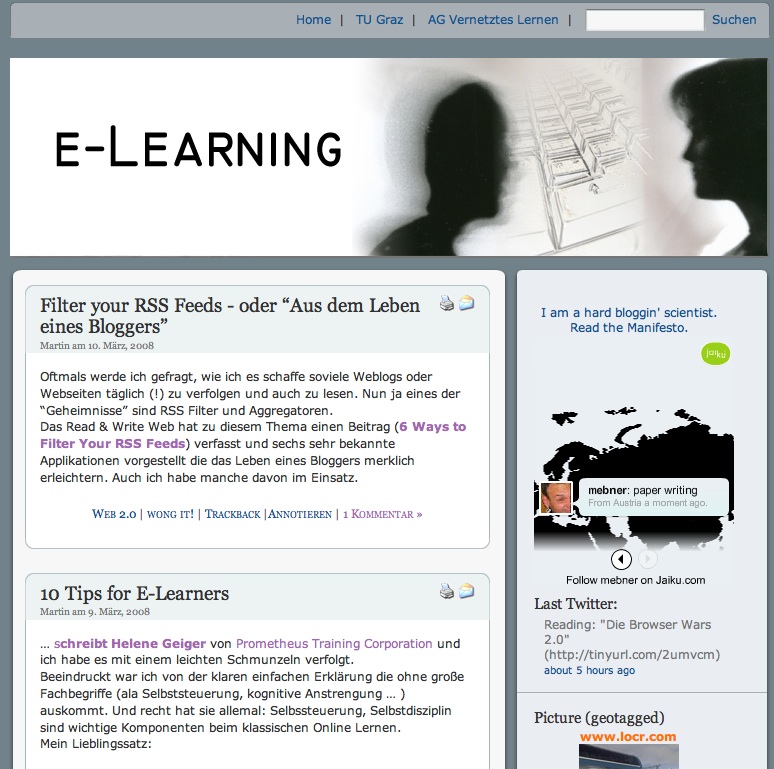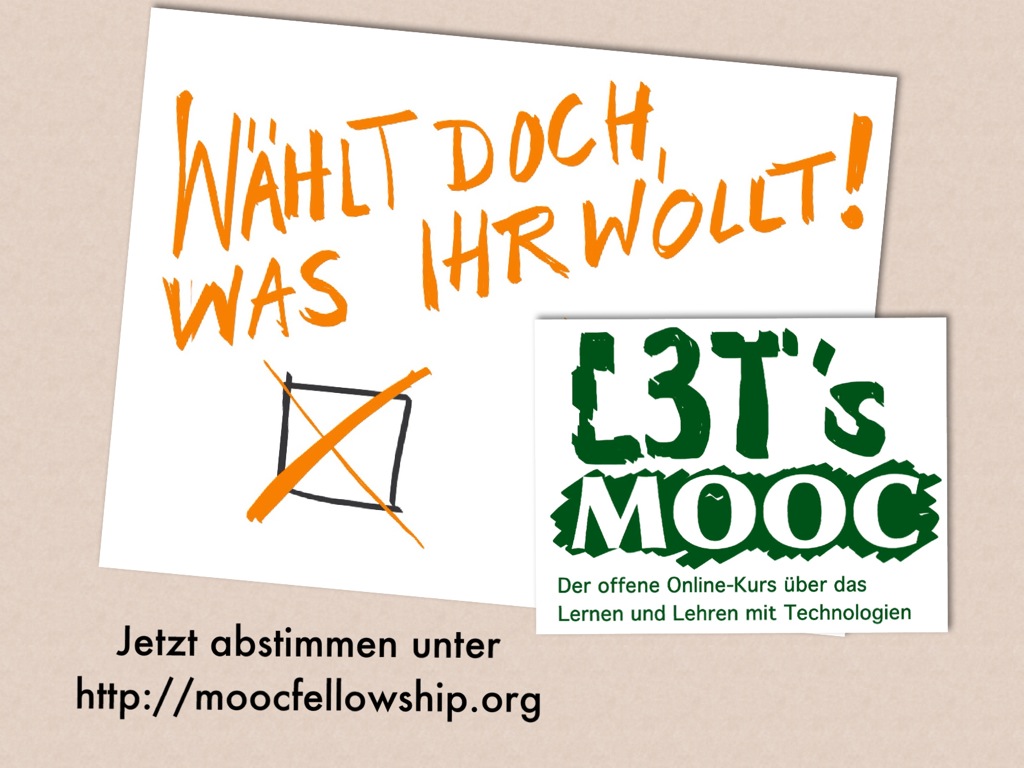L3T 2.0 nähert sich mit Riesenschritten – Camps werden organsiert, Techniken abgestimmt, KapitelautorInnen kontaktiert und, und, und, …. und es gibt auch die erste Version des Community-Videos. Wer Lust hat noch mitzumachen, ist herzlich dazu aufgerufen (hier gibt es die Anleitung), denn die nächste, erweiterte Version kommt bestimmt:
#coer13 Die Finanzierung von Open Education Resources
Bevor es morgen in das Online-Podium geht über die Finanzierung von OER und Open Access, nochmals kurz mein Input von letzter Woche. Ich habe versucht einmal alles soweit darzustellen und auf Möglichkeiten hinzuweisen OER finanzierbar zu machen.
Hier gibt es die Folien dazu:
Klicken Sie auf den unteren Button, um den Inhalt von de.slideshare.net zu laden.
Und hier die Aufzeichnung meines Vortrages bei Adobe Connect:
[book] Hochschuldidaktik im Zeichen von Heterogenität und Vielfalt
 In der Doppelfestschrift für Peter Baumgartner und Rolf Schulmeister mit dem Titel „Hochschuldidaktik im Zeichen von Heterogenität und Vielfalt“ haben ich und (natürlich) Sandra auch einen Beitrag zu offenen Bildungsressourcen beigetragen. Der Titel unseres Beitrages lautet „Offene Bildungsressourcen als Auftrag und Chance – Leitlinien für (medien-) didaktische Einrichtungen an Hochschulen„.
In der Doppelfestschrift für Peter Baumgartner und Rolf Schulmeister mit dem Titel „Hochschuldidaktik im Zeichen von Heterogenität und Vielfalt“ haben ich und (natürlich) Sandra auch einen Beitrag zu offenen Bildungsressourcen beigetragen. Der Titel unseres Beitrages lautet „Offene Bildungsressourcen als Auftrag und Chance – Leitlinien für (medien-) didaktische Einrichtungen an Hochschulen„.
Die Zusammenfassung:
Offene Bildungsressourcen (englisch „open educational resources“, kurz OER) sind nicht nur kostenfrei zugänglich, sondern sind ausdrücklich zur Nutzung für das Lernen und die Lehre freigegeben. In diesem Beitrag werden Beispiele für und Zielsetzungen von OER-Initiativen an deutschsprachigen Hochschulen vorgestellt. Aus Perspektive der Hochschuldidaktik sowie medien- und hochschuldidaktischer Einrichtungen sind sie nicht nur eine weitere technische Herausforderung, aus der sich ein Schulungsbedarf bei Lehrenden ergibt, sondern sie bieten zahlreiche Chancen für Hochschulen und die Hochschuldidaktik. Daher werden wir auf der Grundlage von Vorarbeiten in diesem Beitrag für hochschuldidaktische Einrichtungen Leitlinien entwickeln, mit denen sie erfolgreich die Bewegung zu offenen Bildungsressourcen unterstützen können.
Unser besonderer Dank gilt Gabi Reinmann für ihr Feedback sowie insbesondere den vier ausgewählte Leiter/innen von hochschuldidaktischen Einrichtungen bzw. E-Learning-Zentrumsleiter/innen die unseren ersten Entwurf für die Leitlinien für (medien-) didaktische Einrichtungen an Hochschulen zur OER-Einführung geschickt hatten und um ihre Kommentare gebeten haben: Herzlichen Dank an Ortrun Gröblinger (E-Learning-Zentrum Universität Innsbruck), Ricarda Reimer (FH Nordwestschweiz, Leiterin der SIG OER bei eduhub), Christian Hoppe (E-Learning-Zentrum der Technischen Universität Darmstadt) sowie Dr. Sebastian Kelle (Stabsstelle Hochschuldidaktik, Hochschule der Medien Stuttgart).
Der Beitrag ist wie das gesamte Buch ist wie bereits angekündigt beim BIMS e.V. mit Open Access erhältlich oder kann hier auf Amazon bestellt werden:
- Ebner, Martin & Schön, Sandra (2013). Offene Bildungsressourcen als Auftrag und Chance – Leitlinien für (medien-) didaktische Einrichtungen an Hochschulen. In: Gabi Reinmann, Martin Ebner & Sandra Schön (Hrsg.), Hochschuldidaktik im Zeichen von Heterogenität und Vielfalt. Doppelfestschrift für Peter Baumgartner und Rolf Schulmeister, URL: https://bimsev.de/festschrift, Norderstedt: BoD, S. 7-28.
Blogparade: Hilfe, mein Prof blogt!
Im Rahmen des Saxon Open Online Course (SOOC13) ist wiedermal zu einer Blogparade aufgerufen worden und zwar zu einer durchaus spannenden Frage „Warum blog ich eigentlich?“.
Gute Frage, aber vielleicht erzähl ich einfach meinen Beginn und wie es soweit gekommen ist. Am Anfang (das war immerhin doch schon im April 2006) stand einfach die Neugierde, die Neugierde an der aufkommenden Bewegung Weblogs. Da dachte ich mir seinzeit es ist vielleicht ja ganz nett, wenn ich ab und zu etwas veröffentliche zu meinem Forschungsfeld. Kann ja eigentlich nicht schaden, wenn ich die Sachen die ich sowieso mache einfach online abspeichere und all die Links, Videos die täglich in meiner Mailbox landen einfach sammle. Man könnte es auch so sagen, dass ich es anfangs als reinen „Online-Speicher“ gesehen habe. Ganz für mich alleine, hautpsach ich brauch nicht mehr ewig suchen.
Das habe ich dann ab April 2006 gemacht, etwa 3 Monate später merkte ich, dass ich durchaus nicht wenig LeserInnen hatte (ich stieg da in der täglichen Besucherzahl über 100) und war zunächst noch sehr erstaunt. Kurzum erkannt ich plötzlich die Reichweite die man bekommt, hatte viel Austausch mit anderen WissenschaftlerInnen und bekam ständig weitere interessante Kontakte. Man darf ja nicht vergessen, es war ja noch das Pre-Social-Media-Zeitalter. Facebook & Co kannten wir zwar schon, hatten auch Accounts, aber die Nutzung war damals noch sehr übersichtlich.
2007-2008 war dann die Hochblüte der Blogs, die Besucherzahlen stiegen schier ins Unendliche (ich erinnere mich an Tage mit weit über 1000 BesucherInnen), viel im Netz interessierten sich für diese Form der Kommunikation und wir veröffentlichten dazu auch einige wissenschaftliche Arbeiten wie z.B. zusammen mit Mandy jene der „Blogging Theory„.
Nach dem Hype ging es bergab, viele Blogs wurden stillgelegt und das Interesse pendelte sich zu dem ein, was für mich heute normal ist. Heute würde ich sage, kommunziere ich hauptsächlich über die Sozialen Medien mehr oder weniger in Echtzeit, aber brauch meinen Weblog für Inhalte die Konstanz haben und nicht derart flüchtig sind. Mein Weblog ist nachwievor ein Speicher für mich, der über unsere Arbeit berichtet, sie zugänglich macht (wahrscheinlich liegt dort auch meine Hingabe zur Open Science, Open Access und Open Educational Resources begraben) und dazu dient das Thema „e-Learning“ einen kleinen Schritt voran zu bringen.
Zum Abschluss ein besonderes Schmankerl (zumindest ich muss darüber schmunzeln) – so sah er aus der E-Learning Blog im Jahre 2008:

[L3TsMOOC] Wir sagen DANKE für den 4.Platz beim Online-Voting
 Wir haben länger hin- und herüberlegt, ob wir uns beim MOOC Fellowship beteiligen. Und zwar nicht deswegen, weil wir uns nicht vorstellen können, einen guten MOOC-Antrag zu schreiben, sondern weil wir ja schon wissen, was „Public Voting“ bedeutet.
Wir haben länger hin- und herüberlegt, ob wir uns beim MOOC Fellowship beteiligen. Und zwar nicht deswegen, weil wir uns nicht vorstellen können, einen guten MOOC-Antrag zu schreiben, sondern weil wir ja schon wissen, was „Public Voting“ bedeutet.
Beim MOOC Fellowship ging es ja in der ersten Phase darum, den Ausschreibern (iversity und dem Stifterverband für die Deutsche Wissenschaft) zu zeigen, dass es möglichst viel Unterstützung für den vorgeschlagenen MOOC gibt. Und es ist ja nicht so, dass „die Öffentlichkeit“ darauf wartet, sich irgendwo zu registrieren und abzustimmen (egal zu welchem Thema); vielmehr bedeutet öffentliches Voting viel Arbeit und etliche durchgetippte Nächte. Trotzdem haben wir uns für eine Teilnahme entschieden, weil wir das Fellowship als tolle Möglichkeit betrachten, die Materialien von L3T zu erweitern und natürlich: um das Thema in die Schulen und Hochschulen zu bringen. (und weil wir dazu keine bzw. nicht viele Alternativen haben!).
Und: Es lief von Anfang an gut, und zwar immer so gut, dass wir weiter machen mussten … wir haben daher in der Abstimmungsphase vom 1. bis 23. Mai 2013 wie wahnsinnig getrommelt, ganz nach dem Motto: Wenn wir es nicht gescheit machen, hätten wir es nicht starten müssen, und immerhin läuft es ja gut! Und wir freuen uns nun sehr (!!!) über die großartige (!!!) Unterstützung von vielen Seiten! Auch gerade weil und wenn wir mit unseren Bitten und Anfragen lästig waren.
Wir haben v.a. eine große Zahl an E-Mails geschrieben – an Kontakte oder den Kontaktadressen in allen wichtigen E-Learning-Einrichtungen, -Verbänden und Einrichtungen in D-A-CH, natürlich auch an etliche Lehrer/innenverbände (u.a. GEW und alle Philologenverbände Deutschlands), an die landeseigenen Medienanstalten, an Forschungseinrichtungen, Netzwerke. Um es kurz zu machen: Vor allem da – das war auch unsere Erwartung – wo schon konkrete Erfahrung mit L3T gemacht wurde, fanden wir tolle Unterstützung. Reihenweise zwar nicht institutionell („Meine Uni hat schon einen eigenen Antrag“, „wir wollen uns neutral verhalten“, manchmal sogar auch „wir müssen uns neutral verhalten“), aber dann doch wohlwollend und mit einer privaten Stimme, oder ein Zweit-, Dritt- etc. -Stimme (es gab 10 zu vergeben). Lieben Dank dafür!
Die folgende Liste kann also gar nicht vollständig und abschließend sein, und die Gefahr ist groß, dass wir das ein oder andere übersehen (oder auch gar nicht mitbekommen haben, bitte ggf. melden).
Es haben soooo viele L3T’s MOOC unterstützt und ihnen allen gilt unser Dank, ganz besonders möchten wir uns bedanken bei:
- der TU Graz für eine Meldung auf ihrer Homepage
- der Salzburg Research Forschungsgesellschaft für eine Meldung auf ihrer Homepage
- dem BIMS e.V. für eine Meldung auf der Homepage sowie die tatkräftige Unterstützung zahlreicher Mitglieder
- Futurezone.at für ihren Artikel zu L3T’s MOOC
- Info-Graz.at für ihren Artikel zu L3T’s MOOC
- E-Teaching.org für eine Meldung auf der Homepage
- Creative Commons Deutschland für eine Meldung auf der Homepage
- der „Kleinen Zeitung“ für ihren Artikel
- Eduhub.ch für ihren Beitrag
- der FNMA für die Meldung und die Verteilung des Aufrufs im E-Mail-Verteiler (& Facebook)
- dem Tiroler Bildungsservice für seinen Beitrag
- Dem Magazin Erwachsenenbildung.at für seinen Beitrag
- dem eLSA-Netzwerk für die Meldung auf der Homepage und im Newsletter
- Joachim Wedekind für seinen Beitrag „Wunsch-MOOCs“
- Ellen Trude für ihren Beitrag zu L3T’s MOOC
- Prof. Hofmann für seinen Beitrag zu L3T’s MOOC („better than Harry Potter!“)
- Dörte Giebel für ihren Beitrag zu L3T’s MOOC
- der Piratenpartei BGL für den Beitrag zu L3T’s MOOC, insbesonder Martin Schön, der Piratenpartei Österreich, den Piraten in Tirol und in Bremen sowie den Piraten in Thüringen!
- dem Netzwerk Informationskompetenz Berlin-Brandenburg für seine Meldung
- den Freunden von der Forschungsgesellschaft evolaris, die geschlossen abgestimmt hat, das Voting bei Facebook beworben hat und uns damit kurzfristig auf Platz 3 katapultierte
- für den Beitrag im Weblog fremdsprachenundwebzweinull
- für den Beitrag im Weblog mischschule
- bei Patricia Tirel für ihre Meldung
- für den Beitrag bei der Virtuellen Hochschule
- Andreas Link fürs Mobilisieren von allen Bekannten inkl. Fliesenleger,
- Guido Rössling fürs Mobilisieren von etlichen Studierenden der TU Darmstadt, dank ihm konnten wir gestern halbwegs ruhig schlafen gehen 🙂
- Martins Team, Kolleginnen und Kollegen und Studierenden an der TU Graz, insbesondere der Vorlesung GADI13 sowie Andreas Holzinger fürs persönliche Werben,
- Sandras Kolleginnen und Kollegen bei Salzburg Research,
- allen Unterstützer/innen beim BIMS e.V., insbesondere Martin Schön,
- den (ehemaligen) Kolleginnen und Studierenden der FH Hagenberg für ihre Unterstützung,
- Michael Kopp und seinem Team von der Akademie an der KFU Graz!
- bei den Teilnehmer/innen vom laufenden Onlinekurs COER13, die uns eben großartig unterstützt haben, trotz Dauerfeuer. 🙂
- Kristina Lucius, Ursula Mulley, Heiko Idensen, Alexander Stocker, Siegfried Reich, Dirk Küpper, Daniel Seitz, Christian Kleinhanß, Jürgen Ertelt, Anja Lorenz, Helmut Stemmer, Stefan Blachfellner, Cornelie Picht, Christian Freisleben, Klaus Meschede, Heinz Wittenbrink, Elke Lackner, Andre Spang, Timo van Treeck, … da können wir gar nicht genug aufzählen…. ! … fürs viele Teilen und Empfehlen,
- für alle, die von Bürotür zu Bürotür und in ihren Vorlesungen Werbung gemacht haben – in ganz D-A-CH!
- bei (einigen) unserer Mitbewerber/innen für den netten und informellen Austausch nebenbei :o) – insbesondere an Christian Spannagel und Patricia Arnold!
- bei allen Studierenden-Gruppen und -Fachschaften sowie Schüler/innen-Vertretungen bzw. Schulen, die unseren Aufruf geteilt und weitergeleitet haben: Klasse, dass auch Ihr uns unterstützt habt!
- auch bei allen Verbänden u.ä. die uns über interne Verteiler unterstützt haben,
- und, und, und …. allen anderen mehr als 2.000 Unterstützer/innen!
- natürlich freuen wir uns auch, wenn das Video zum Antrag gefällt und extra erwähnt wird (Thomas Peterseil)
- SPECIAL THANKS TO OUR INTERNATIONAL SUPPORTERS!! (seit Sonntag haben wir um internationale Unterstützung gebeten, das massiv per E-Mail etc. verteilt, und weil iversity am Sonntag Mittag den Blick auf die Zahl der Stimmen frei geschalten hat, konnten wir im Worte Sinne sehen, wie fleißig geklickt wurde) – DANKE
Während es am 30.4.13 noch keinen einzigen Treffer bei Google zu „L3T’s MOOC“ gab, waren es am 18. Mai bereits etwa 2.740 Treffer. (Quelle, Stand 18.Mai 2013)
Gestern abend, also am 22.5.2013 sah es dann kurz vor Mitternacht schon so aus:
Wir finden ja ganz unbescheiden, für diese Liste hat L3T’s MOOC zumindest schon mal in der Öffentlichkeitsarbeit volle Punktzahl verdient! 🙂
Also: Herzlichen Dank an alle, dass wir das soweit geschafft haben! – Bis zum 10.6. kommt die Jury zu einer Entscheidung, welche Einreichungen den Zuschlag bekommen, und am 20.6. werden diese in Berlin offiziell bekannt gegeben. Wir halten uns jetzt erst mal die Klappe, nerven Euch nicht mehr in den Netzwerken und: Drücken nun die Daumen 🙂
[GADI13] Anreizsysteme und Connected TV

 Ich darf heute, Mittwoch 22.05.2013, zur leider wieder schon letzten Vorlesung „Gesellschaftliche Aspekte der Informationstechnologie“ an der TU Graz einladen. Der achte Termin besteht aus folgendenden Vorträgen:
Ich darf heute, Mittwoch 22.05.2013, zur leider wieder schon letzten Vorlesung „Gesellschaftliche Aspekte der Informationstechnologie“ an der TU Graz einladen. Der achte Termin besteht aus folgendenden Vorträgen:
- Sandra Schön: „Macht mit im Web! Wie Anreize und Anreizsysteme Webaktivitäten unterstützen„
- Christian Kittl: „Connected TV – Revolution im Wohnzimmer?„
Die Vorträge werden live ab 16.15 Uhr gestreamt – Link zum Streamingserver
Weitere Vorträge/Abstracts findet man hier auf der Vorlesungshomepage.
Warum das Internet die Bildung verändert
Ich bin eingeladen worden einen Gastbeitrag zur Bildungsoffensive bei futurezone.at zu schreiben. Unter dem Titel „Warum das Internet die Bildung verändert“ habe ich in den wenigen Zeichen versucht darzustellen, wieso es zwingend ist Medienkompetenz in die Schulen zu tragen:
Die Bildung ist zweifelsohne eine der wesentlichsten Säulen unserer Gesellschaft. Nur erfährt eben diese auch einen großen Wandel ausgehend von technischen Innovationen allen voran das Internet, schreibt Martin Ebner von der TU Graz in einem futurezone-Gastbeitrag.
L3T’s MOOC – Alle Fragen beantwortet
Noch drei Tage werden Stimmen gesammelt, um für das MOOC Fellowship von iversity und dem Stifterverband der deutschen Wissenschaft in die engere Auswahl zu kommen. Wir sind mit unserem Antrag „L3T’s MOOC“ dabei und stehen damit, dank großartiger Unterstützung!!, seit mehr als einer Woche in den Top Ten.
Drei Fragen, die uns immer wieder gestellt worden sind, möchten wir noch beantworten, bevor das öffentliche Voting zu Ende geht:
Was macht Ihr eigentlich mit dem Geld?
Kurze Antwort: Es finanziert die Grundlagen eines MOOCs, aber nicht uns/unsere Stellen.
Das MOOC Fellowship umfasst 25.000 Euro. Das klingt auf dem ersten Blick sicher für viele wie eine riesige Summe (privat ist es das für uns auch :o), ist es aber nicht, wenn man sieht, dass die Kosten für eine MOOC-Kursentwicklung und Durchführung bei anderen mit mit einem Faktor 14 teurer veranschlagt werden. (Wir waren deshalb auch sehr überrascht, dass es so viele Mitbewerber gibt). Mit 25.000 Euro alleine, ist noch kein MOOC finanziert (bei COER13 sind wir z.B. 6 Mitveranstalter, einige mit mehreren Personen und die Betreuung der Lernenden ist nicht intensiv, es ist auch kein Kurs auf akademischen Niveau und auch nur halb so lang wir L3T’s MOOC – und es ist ein deutlich spezielleres Thema, OER, als L3T’s MOOC). Wir vermuten daher, dass viele sich gedacht haben: Mit dem Geld finanzieren wir das Livestreaming unserer Vorlesung – oder vielleicht auch sowieso schon einen MOOC planten und es als Ko-Finanzierung sehen. Vermutlich haben sich auch einige nicht viel dabei gedacht und haben den Antrag nur geschrieben, um „dabei“ zu sein. 🙂
Unsere Kalkulation sieht so aus: Etwa die Hälfte der 25.000 Euro benötigen wir um passende Lernvideos sowie Aufgabenstellungen gemeinsam mit 8 Experten aus ganz D-A-CH in 5 Tagen zu gestalten; inkl. Technik, Input von anderen (Sprechtraining, Kamera), Anreise und Aufenthalt. Das großartige ist ja: Wir können hier auf die Texte und Materialien von L3T zurückgreifen, müssen also nichts grundsätzlich neu erfinden, sondern „nur“ passend gestalten. Die andere Hälfte haben wir für (studentische) Tutoren veranschlagt (Upload zu iversity, technische uns sonst. Betreuung der Teilnehmer/innen, der Expert/innen etc.). 2.000 Euro sind für PR geplant: Der beste MOOC bringt nichts, wenn ihn die Personen nicht kennen, für den wir ihn machen. Sandra und mein „Job“ an der Sache ist also selbst nicht bzw. im besten Falle zum kleinen Teil finanziert.
Macht Ihr das alleine?
Kurze Antwort: Nein, hoffentlich nicht! 🙂
Nein, das geht doch gar nicht! Wir haben beim Antrag schreiben schon ein paar L3T-Mitstreiter/innen gefragt, ob sie sich am Antrag beteiligen wollten. Da gab es jedoch mehrere Interessenskonflikte, weil sie selbst schon eigene Anträge ins Rennen bringen wollten. Wenn es mit L3T’s MOOC klappen würde, hoffen wir aber natürlich auf eine sehr starke Unterstützung des L3T-Netzwerkes und darüber hinaus: Wir wollen ein Angebot für Lehramtstudierende und Lehrende schaffen, sich mit dem Einsatz von Technologien zum Lernen und Lehren auseinanderzusetzen, und da sind wir natürlich auf eine Vielzahl von Expertinnen und Experten angewiesen, die den MOOC in Live-Sessions, in Arbeitsgruppen, etc. ergänzend (stunden- oder wochenweise) unterstützt. Wir denken da z.B. an Schwerpunktthemen wie bestimmte Schulfächer, bestimmte Technologien) … (und nein: Finanzierung haben wir dafür keine, siehe oben, aber wir freuen uns sehr all diejenigen die sich hier (intensiver) einbringen wollen als offizielle Partner aufzuführen!) … aber es macht noch wenig Sinn, groß über ungelegte Eier zu diskutieren, denn:
Kommt L3T’s MOOC auch, wenn Ihr keine Förderung bekommt?
Nein, zumindest nicht von uns.
Diese Frage ist völlig berechtigt, haben wir ja auch L3T in der ersten Runde ohne Förderung gemacht, in der zweiten Runde haben wir zwar dank Netidee.at eine Grundfinanzierung, aber das meiste läuft immer – insbesondere auch bei allen der Beteiligten im L3T-Netzwerk im Rahmen der Freizeit oder mit Unterstützung/Nachsicht der Arbeitgeber. Damit wir – also Sandra und ich – L3T’s MOOC durchführen können, fehlen uns eigene Infrastrukturen (z.B. eine bereits bestehende Einführungsveranstaltung mit vielen hundert Studierenden und vorhanden Tutoren, die man hier auch beim MOOC miteinsetzen könnte). Und alles aus dem „nichts“ zu hebeln: Da sehen wir derzeit keine Möglichkeiten.
Das bedeutet jedoch nicht, dass es keinen MOOC geben kann oder wird, der auf L3T aufbaut. Gerade weil das neue L3T ja entsprechend liziensiert wird (CC BY SA) ist es prädestiniert als Material in ggf. ähnliche deutschsprachige Angebote einzufließen. So werden jetzt schon L3T-Kapitel auch bei anderen Einreichungen beim MOOC Fellowship gelistet. Vielleicht gibt es jemanden, der dann einen MOOC rund um L3T macht. Für Sandra und mich können wir jedoch definitiv sagen: Ohne Grundfinanzierung können wir L3T’s MOOC nicht durchführen.
Achja, und wer noch nicht hat: Bitte (auch) für L3T’s MOOC abstimmen! (dazu genügt die Eingabe der E-Mail-Adresse, ein erfundenes Passwort) – jede/r hat übrigens 10 Stimmen (je MOOC eine).
#COER13 [presentation] OERfahrungen von 1. bis 7
Sandra Schön und ich sind gefragt worden, ob wir nicht aus unseren zahlreichen OER-Erfahrungen Tipps und Hinweise für eine geplantes Projekt geben können: Die Werkstatt bpb möchte zum Thema „100 Jahre Erster Weltkrieg“ kollaborativ offene Bildungsressourcen erstellen und startet am Mittwoch mit einem ganztägigen Workshop in Berlin. Gegen Mittag werde ich zugeschalten werden und versuchen, die „richtigen“ Erfahrungen und Tipps mit auf dem Weg zu geben. Es geht also nicht nur um Lizenzfragen, sondern u.a. auch darum, wie man ein OER-Projekt mit Vielen planen sollte – zumindestens aus unserer Erfahrung eben. Weil live gestreamt wird, können sich auch Interessierte aus COER13 zuschalten. Der Livestream wird hier angekündigt werden: https://werkstatt.bpb.de/2013/05/open-educational-development-im-livestream/ oder auch hier zu finden sein werkstatt.bpb.de – und gezwitschert wird mit #oed13.
Und weil es bis zum 23.5.13 gar nicht anders geht, fehlt natürlich auch nicht die Bitte um Stimmen beim MOOC Fellowship. Bitte stimmt für L3T’s MOOC (E-Mail-Adresse genügt).
Und hier die Folien zum Schnuppern (oder Nachlesen 😉 ):
Klicken Sie auf den unteren Button, um den Inhalt von de.slideshare.net zu laden.
#COER13 Online-Lehrkurs: Österreicher hoffen auf Preis
 Danke an die futurezone.at, die uns auch beim Aufruf unterstützt für L3T’s MOOC zu stimmen – es geht noch gut eine Woche und wir bedanken uns bei allen, die auf den grünen „Abstimmen„-Button drücken und sich via E-Mail-Adresse registrieren. Wir würden uns sehr freuen wenn wir diesen frei zugänglichen, offenen Massive Open Online Course im Frühjahr 2014 anbieten können 🙂 .
Danke an die futurezone.at, die uns auch beim Aufruf unterstützt für L3T’s MOOC zu stimmen – es geht noch gut eine Woche und wir bedanken uns bei allen, die auf den grünen „Abstimmen„-Button drücken und sich via E-Mail-Adresse registrieren. Wir würden uns sehr freuen wenn wir diesen frei zugänglichen, offenen Massive Open Online Course im Frühjahr 2014 anbieten können 🙂 .
Link zum Beitrag: Online-Lehrkurs: Österreichen hoffen auf Preis



